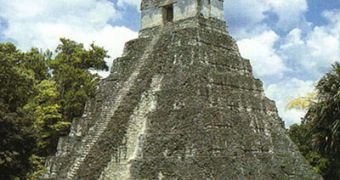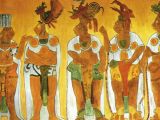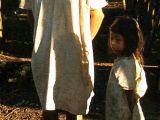There were three great civilizations in America before its discovery by the Europeans: Aztec, Inca and Maya; but Maya was by far the most advanced culturally and artistically. Maya civilization developed in the area where nowadays we have Guatemala, Honduras, El Salvador and southern Mexico, in a mountain area of tropical forests. The clime is rainy, the soil limy and not very proper for agriculture. During the rainy season, the area becomes a wetland plagued by mosquitoes, still, the Maya managed to create an amazing civilization, a magnificent architecture with splendid cities, pyramidal temples 60 m (200 ft) tall and sport fields in which they played ritual ball games.
Maya sculpture, made in limestone, made extremely beautiful reliefs and sculptures; painting was characterized by the vivacity of the colors and the perfect harmony of the groups. Moreover, Mayans were the sole people of the prehispanic America which created a complex writing, a counting system, and a calendar forecasting the minimal fixings, their astronomical knowledge overpassed that of the contemporaneous Europeans. Unfortunately, only three Maya books have been preserved and their hieroglyphic writing has not been completely decoded.
Like in ancient Mesopotamia, each of the Maya city was the center of a small state led by rulers, priests and law makers. From time to time several cities formed a confederation. The most important Maya cities were: Tikal, Copan, Coba, Chichen Itza, Palenque, Quirigua, and Uxmal. Many cities were pilgrimage religious centers, where people from all the corners of the region made their prayers to the gods; to Chichen Itza people went for asking for rainfall and make sacrifices to the famous cenote (enormous natural well). The cities lacked walls (useless as unlike Incas and Aztecs, Mayans were much more peaceful).
In the center of the cities were big and beautiful squares, next to which were the pyramid temples, priest houses, markets, public wells, and the stadiums for the ball game. On the outskirts were located the houses of the lower classes, farmers and craftsmen, simple, made of adobe, with roofs made of branches.
Maya believed in a series of gods controlling the stars. The supreme god was Itzamna, the god of the sky, followed by the gods of the Sun, Moon and Venus. The four cardinal points were ruled by four gods, the Chaces, which controlled the rain and conferred fertility to the crops. Minor gods were those of the corn, wells, rivers, mountains, trees, and so on. They worshiped also Quetzalcoatl, the feathered snake, a god-turned hero, coming from north, from the central Mexico (Aztecs too worshiped Quetzalcoatl).
The temples amazed Europeans through their size and proportions. They were pyramidal trunks whose surfaces were crossed by ample staircases leading to the proper sanctuary, small construction adorned by beautiful reliefs.
Like modern Mayans, ancient Mayans were short, well built, with large thorax and short, muscular limbs. The face was wide, with steep cheeks, slightly oblique eyes and aquiline nose; the hair was straight and black. The ancient Mayans used to deform their heads for having a lengthened skull, fact achieved by placing a small plate in front and another on the occipital zone of the newborn children and by tying them strongly, the still soft bones of the toddlers adopted the desired shape.
Modern Mayans are sober, fatalist, superstitious, silent, skilled, faithful and loyal. But they lost the intellectual and artistic sophistication of their ancestors; the Spanish conquest wiped out their upper classes and impaired the practice of their own culture.
Ancient Mayans were extremely religious, that's why their society was dominated by the priests' class that served as intermediaries between gods and men. In fact, only the priests understood astronomy and how to make gods act in the favor of humans. The priests occupied the highest rank in the society, being overcome just by the ruler of the city-state. Priests intervened in administration and sometimes they assumed the powers of the ruler.
The Mayan knew two peak periods: the Old Empire (300 to 900 AD), a peaceful period, and the New Empire (900 to 1500 AD), a period characterized by attacks from their neighbors, Aztecs included, fact that determined the appearance of a warrior class and the Sun god was turned into the god of War. Mayan warriors were brave and skilled and Spaniards needed much more time to subdue Mayans than the fearsome Aztecs. In fact, because Mayans were not centralized like the Aztecs, various expeditions were required to subdue one by one the Mayan states. Aztecs were conquered in two years, Mayans in 170 years!
Mayan women prepared corn tortilla just like today Mexican women in rural areas do. Another basic food were red beans with chili pepper, and recently was found they also cultivate manioc. Men used to cultivate parcels in forest clearings. Mayans were the only native Americans to practice apiculture, before the European colonization of the Americas. Mayans kept some stingless bees (the honeybees are exotic in Americas) just for honey. Maya people even venerated a bee-god, named Ah Muzen Cab.
Women wove fine cotton fabrics with nice combinations of colors (some resembling gauze), and modern Maya women still employ them in traditional skirts and hulpil (sleeveless blouse). The models on the fabrics are not hand made but inter-woven. Mayan also processed sisal hemp, with which they made webs and ropes. Villagers used to wear clothing made of bark material beaten till left soft and flexible.
The priests and high rank people wore high feathered head adornments, made with feathers of parrots, toucans, turkeys and especially quetzal, Guatemala's national bird, with shiny green feathers and an extremely long tail. They also wore feathered crowns, cloaks and scepters, and a high variety of necklaces, earrings, and belts.
Priests were coated in ocelot skin made cloaks to make human sacrifices. These sacrifices were not so often and turning into hecatombs like in the case of Aztecs, but in scarcity years they used to sacrifice some slaves or war prisoners. The victims destined to be sacrificed were carefully treated during the year before the sacrifice, like in the case of Incas, a period when all their wished and caprices were accomplished. At the term, the victim was headed to the temple, climbed the ample staircases, where four priests held on him over an altar located before the sanctuary: the nacom (high priest) opened up his chest with an obsidian knife and pulled out the heart offered to the divinity.
Many modern Mayans preserve many of the aspect of the ancient Maya culture. Some Maya groups formed the Lacand?n population, the only Native Americans in Spanish colonies never conquered by Europeans. They escaped Spanish control during the colonial era by living in small, remote farming communities in the jungles of what is now southern Mexico and neighboring Guatemalan, avoiding contact with whites and Ladinos. Lacand?ns preserve many ancient Maya customs.
As recently as the late 19th century, some Lacandons still shaped the heads of infants, inducing the distinctively shaped foreheads observed in Classic Maya art. By the 20th century, the Lacandons still employed bows and arrows for hunting peccaries (a type of wild pigs) and deer and made arrowheads from flint, refusing to use firearms. They make primitive canoes made from caoba (Swietenia) trunks, fishing with bows, arrows and traps. Unlike Classical Mayans, that wore complete sophisticated clothing, Lacandons wear loincloth. The return to Neolithic, in a forest dominated by ceibas (Ceiba, the world central tree in Maya mythology), caobas, rubber trees, orchids (like vanilla), and Hibiscus.

 14 DAY TRIAL //
14 DAY TRIAL // 

